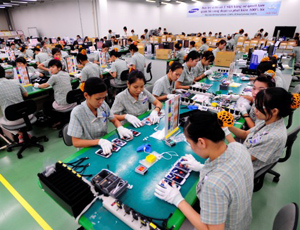
| Samsung to Build US$1 Billion Plant in Vietnam | |
Vietnam continues to strengthen its relationship with Samsung. On July 2, Bac Ninh province granted an investment license to Samsung Display Co. Ltd for its US$1 billion project in the Yen Phong Industrial Park. This investment comes on the back of multiple large scale investments by the South Korean tech giant. - See more at: http://www.vietnam-briefing.com/news/samsung-build-us1-billion-plant-vietnam.html/#sthash.DgKvl7fI.dpuf The new plant will supply small displays for Samsung’s smartphones and tablet computers and is expected to be the largest Samsung factory of its kind in the world.
Samsung has been able to negotiate exceedingly favorable conditions from the Vietnamese government for the building of this new factory – Vietnam is keen to attract more high-technology companies. According to the company’s investment license, Samsung will receive numerous concessions from Bac Ninh province, these include:
Samsung Display expects to hire around 8,000 workers. For every worker, the company will receive VND1.5 million (US$70.5) – it will receive VND12 billion (US$564 thousand) in total. However, this plan will only begin once the province starts receiving taxes from Samsung. The province will issue these payments every year until the fund is empty. RELATED: New Investment Opportunities in South Vietnam: An Interview with Long Hau Industrial Park Samsung’s key partner in the building of the plant is the Viglacera Construction Company. The plant is expected to begin operations in the first quarter of 2015, with a monthly production of four million units, increasing to more than 15 million units in 2020. This project will provide employment opportunities for 2,500 people in 2015 and 8,000 people in 2020. As a result of this billion-dollar project, Samsung expects to earn US$1.5 billion in 2015, US$4 billion in 2018, and US$6 billion in 2020. According to data from Vietnam’s government, South Korea is the second largest foreign investor in Vietnam, behind only Japan. Manufacturers are drawn by Vietnam’s low wages, young labor force and generous tax benefits. Every province in Vietnam has its individual policies related to foreign investment, but they are all geared towards creating a more favorable business environment and the creation of beneficial investment deals for foreign investors. The case of Samsung makes clear how serious the country is in attracting high levels of foreign investment. It is also clear that the government is continuing forward with its plan of moving from an economy based on low-end manufacturing to a value-added high-technology economy.
| |
| Vietnam Briefing |
